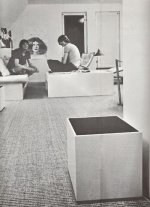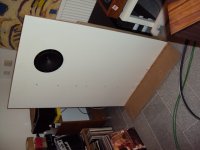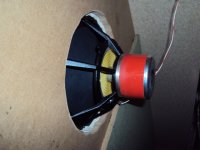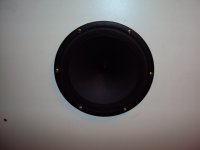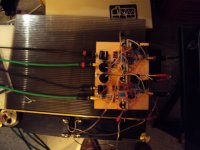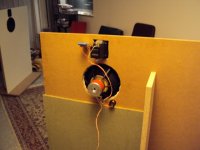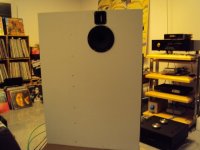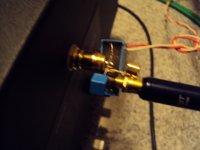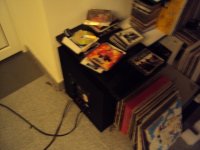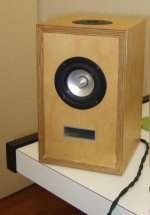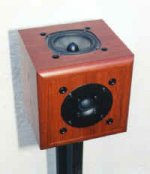I tested the Visaton B200 and also the Seas Exotic 4 Ohm.
The Visaton has a lot of distortion in the treble, the SEAS has a wither cone that creates problems. The SEAS was designed by Björn Börja the senior engineer at SEAS.
Dr. Kurt Müller is a supplier of membranes from Germany with subsidary in England.
We can make a wideband that has more extention in the treble but radiation pattern is a problem like LineArray said. We can make Neodymium versions that are not so expensive then Alnico versions.
Widebanders have not the best resolution in the higher treble ether.
They have to work in the breakup region and have a issue with moving mass.
That is the reason i will use a ribbon tweeter.
The other driver has been measured with other equipment by another person so this measurements are not directly comparable.
When i get the finished driver ( without peak) i will do the measurements with my equipment again.
The Visaton has a lot of distortion in the treble, the SEAS has a wither cone that creates problems. The SEAS was designed by Björn Börja the senior engineer at SEAS.
Dr. Kurt Müller is a supplier of membranes from Germany with subsidary in England.
We can make a wideband that has more extention in the treble but radiation pattern is a problem like LineArray said. We can make Neodymium versions that are not so expensive then Alnico versions.
Widebanders have not the best resolution in the higher treble ether.
They have to work in the breakup region and have a issue with moving mass.
That is the reason i will use a ribbon tweeter.
The other driver has been measured with other equipment by another person so this measurements are not directly comparable.
When i get the finished driver ( without peak) i will do the measurements with my equipment again.
We can make a wideband that has more extention in the treble but radiation pattern is a problem like LineArray said.
that depends
of course You are right in case of conventional front firing speakers BUT my idea is something different, something aptly called "ceiling flooder" and which is a kind of Sonab V1 turned to serious speaker project
essentially a short speaker with 8 inches full ranger on top firing up towards the ceiling, for such speaker I propose Beverigde or near-corner placement
my idea behind this project is of high fidelity that is available for any interested music lover, that is just like any other "room service", genuine a Hartley's ideal, not jewel-like boutique gadgetry, not big ugly technical things almost in the middle of the room, but something that is quite inobtrusive, that would work properly in a typical living room, that takes minimal space close to walls and requires no decor-destroying "acoustical adaptations"
in case of such "ceiling flooders" high directivity or even frequency dependent "discontinuities in angular dispersion" are not of critical importance because:
1) the diffuse sound field they create in a typical room is dominated by reflections from the "flooded" ceiling which is the largest reflective surface in the room (thus contributing mostly to the created sound field) and
2) those reflections are quite uniform spectrally because the speakers typically are "flashing" at the ceiling from considerable distance of 2.5 m or more (speaker drivers are just 20 cm above the floor) so not at particularly acute angles where one can find those "frequency dependent discontinuities"
what I need is good 8 inches full ranger, without shouts and able to produce real bass in a small "acoustic suspension" with help of "boundary room augmentation", I see it as continuation of Villchur-Allison line of thinking
Problem is that I cannot see any such driver on the market and therefore I am so interested in this thread
We can make Neodymium versions that are not so expensive then Alnico versions.
neodymium version would be great
Widebanders have not the best resolution in the higher treble ether.
They have to work in the breakup region and have a issue with moving mass.
That is the reason i will use a ribbon tweeter.
well, certainly BUT there are reasons for full range afficionados' preference for full range ie. one way and for that such thing is considered an ideal
of course with real world speakers it is all about tradeoffs
but add tweeter and we are in the multi way territory, something is gained but something is lost as well
for full range afficionados that what is lost is more important but it is of course a matter for another discussion
and if we decide to go multi way then why use old fashioned full range wideband paper drivers at all? and why cross the tweeter so high?
at 6 kHz ribbon tweeter would not help with beaming and "discontinuities in angular dispersion" or with breakup problems because they start two octaves lower, it can only add some otherwise (subjectively for some audiophiles) missing highs, like in case of the above linked Hotei speaker
best regards!
graaf
ps.
on the attached illustration is Sonab V1, it utilized whizzered 8 incher from Philips
Attachments
Last edited:
Asymmetric mounting makes my heart open wide !
Real "cultic" look that driver, beautiful enough to
make some photos of the driver solely ....
Maybe on smoke glass shelf or a black reflecting background
From cultic look alone competitive with other cultic drivers for sure,
and looks well manufactured, large spider venting ...
What kind of material is the surround ?
Pictures seem a little unterexposed.
Real "cultic" look that driver, beautiful enough to
make some photos of the driver solely ....
Maybe on smoke glass shelf or a black reflecting background
From cultic look alone competitive with other cultic drivers for sure,
and looks well manufactured, large spider venting ...
What kind of material is the surround ?
Pictures seem a little unterexposed.
Rehde was the Audax designer for may years. The membranes where made for him by Audax.
Can it explain the end of the Rehdeko?
I mean Harman started liquidation of Audax speaker division in 1999 and in 2001 Mr Rehde closed His business IIRC.
Joel Rehde suggested that it was due to lack of supply parts of adequate quality and that in the end it was closing of the business that was the cause of death of His father.
in a sense corporate killer Harman killed one great artist
I know a lot about Rehde but i do not like to discuss this here. He certainly had a very interesting and fullfilling life.
...........
Some days ago i got the fitting tweeters for my "Extended Midrange Drivers" as i will call them. They can be made to go to 12kHz but higher then that you need a wizzer cone and the designer whanted to avoid that. Wizzers cause a lot of trouble in the frequency and time domain so i decided on an "Overtone" tweeter that comes in slowly over 7kHz.
The tweeter i choose is a ribbon with horn made by Fountek. In Germany they are sold under the Audaphon and Dynavox brand with wildly varying price and image.
i do not care about that and the tweeter is actually very good and has the ideal radiation pattern and sensitivity. I made a simple and fast 6dB crossover that worked surprising well also in the time domain. I will show measurements later when the tread develops because i found that publishing preliminary data here causes a lot of confusion. People take that simply much to serious and the driver is still under development although the path where to go is cast.
My setup now is the JG Self Preamp with two cables, one goes to the active subwoofer and one goes to my main amp where i filter the MPL with a cap in series with the input impedance of the amp. It´s a kind of semi active setup that i use ones in a while since the early 80th. Actually i find it more transparent souding then most fully active solutions i tried. Lots of extra electronics and cables must not automatically guarantee better sound.
Bargainers will love the 0.6mm twisted solid core cables. Yes, i think for a dipole with 95 - 96dB sensitivity and 8 Ohm it is adequate when it is not too long.
Nicer cabinets will be build and i also build two different dipole woofers that will complement the MPL better then the closed monopole so this setup is really an early bird. Sounds very nice though. Lots of resolution and dynamics that are simply swallowed in spaekers with more damping.
...........
Some days ago i got the fitting tweeters for my "Extended Midrange Drivers" as i will call them. They can be made to go to 12kHz but higher then that you need a wizzer cone and the designer whanted to avoid that. Wizzers cause a lot of trouble in the frequency and time domain so i decided on an "Overtone" tweeter that comes in slowly over 7kHz.
The tweeter i choose is a ribbon with horn made by Fountek. In Germany they are sold under the Audaphon and Dynavox brand with wildly varying price and image.
i do not care about that and the tweeter is actually very good and has the ideal radiation pattern and sensitivity. I made a simple and fast 6dB crossover that worked surprising well also in the time domain. I will show measurements later when the tread develops because i found that publishing preliminary data here causes a lot of confusion. People take that simply much to serious and the driver is still under development although the path where to go is cast.
My setup now is the JG Self Preamp with two cables, one goes to the active subwoofer and one goes to my main amp where i filter the MPL with a cap in series with the input impedance of the amp. It´s a kind of semi active setup that i use ones in a while since the early 80th. Actually i find it more transparent souding then most fully active solutions i tried. Lots of extra electronics and cables must not automatically guarantee better sound.
Bargainers will love the 0.6mm twisted solid core cables. Yes, i think for a dipole with 95 - 96dB sensitivity and 8 Ohm it is adequate when it is not too long.
Nicer cabinets will be build and i also build two different dipole woofers that will complement the MPL better then the closed monopole so this setup is really an early bird. Sounds very nice though. Lots of resolution and dynamics that are simply swallowed in spaekers with more damping.
Attachments
i thought a loudspeaker thread without measurements is a bit boring so i am braking my new rule and show measurements of the MPL 1.0 MHT baffle prototype. Just ignore the 3.5kHz peak if you can. We are working full steam on avoiding it and my supplier has made samples without it.
A loudspeaker is of cause not only defined by frequency response and distortion, timedomain behaviour and radiation pattern are as important.
I will post that information here. Radiation Pattern will come later.
The tonal balance was made with a new postprocess called "Central Spectrum" and takes the human ear into account. For example the human ear has varying sensitivity over frequency and hears a peak stronger than a hole in the response. Higher resolution FRD data is also shown.
Look at the good time domain behaviour and the low distortion i have measured now with highr precission then before.
Based on the time domain behaviour this is like a wideband although i use an "overtone" tweeter.
A loudspeaker is of cause not only defined by frequency response and distortion, timedomain behaviour and radiation pattern are as important.
I will post that information here. Radiation Pattern will come later.
The tonal balance was made with a new postprocess called "Central Spectrum" and takes the human ear into account. For example the human ear has varying sensitivity over frequency and hears a peak stronger than a hole in the response. Higher resolution FRD data is also shown.
Look at the good time domain behaviour and the low distortion i have measured now with highr precission then before.
Based on the time domain behaviour this is like a wideband although i use an "overtone" tweeter.
Here some more.
Group delay at 1khz seems close to 2mS , which is within
the ear threshold senstivity of this parameter at this frequency..
i thought a loudspeaker thread without measurements is a bit boring so i am braking my new rule and show measurements of the MPL 1.0 MHT baffle prototype.
BEAUTIFUL measurements and really a fullrange
great that You decided to take up this project and to post about it here
an "overtone" tweeter, save it is really silent below ca 5 kHz, is an ok idea, many listeners would prefer it, although some people report that making sound form such a tweeter it delayed/reflected is very beneficial, example:
"Central Spectrum" makes a lot of sense, standard plots are very misleading, because people have no understanding of how much the ear differs from a microphone
of course all fullrangers' measurements would benefit from such presentation
distortion measurements @80 dB/90 dB?
what are the T-S?
best regards!
graaf
ps.
here is the missing example:
best,
graaf
an "overtone" tweeter, save it is really silent below ca 5 kHz, is an ok idea, many listeners would prefer it, although some people report that making sound form such a tweeter it delayed/reflected is very beneficial, example:
here is the missing example:
Maybe that is why, trying to find the best spot for a super/support tweeter on my w5-1611sa Tangband FR's, I had the best soundstage, with the easyest to locate instruments, with the tweeter way back or facing sidewards on top of the box.
(I made a small box for the tweeter)
As soon as I put it at the front on top of the box, soundstage diminished, and instruments seemed to "shift" a little as they played different tones. There where also more "ghost" images of voices and instruments. Very hard to describe this..
It almost seems if the soundstage was more empty and easy, with "only" the instruments and voices that were supposed to be there, when the tweeter was aligned to the side.
Without the support tweeter I was missing a lot of detail in comparison to my fullrange speakers. So it seems that in spite of the tweeter only radiating indirectly, its sound does add up in our brain as details, but doesnt help at localization of instruments. its sound probably comes "to late"...
best,
graaf
nice
what's interesting it perhaps can work also the other way round like in case of Samadhi Cube
